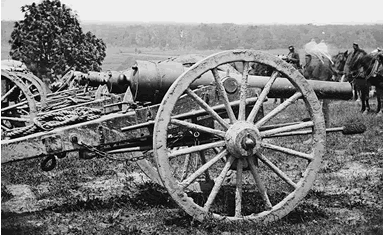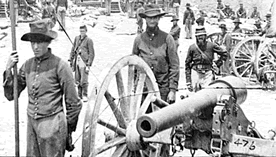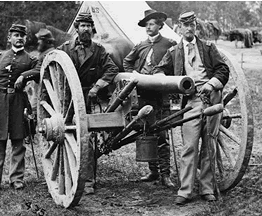Federal artillery east of the Antietam
30 November 2007

Artillery Hell (James Hope, Antietam National Battlefield)
A few days ago I was prompted by a TalkAntietam query to look into the strength of the Federal Artillery at Antietam on 17 September 1862. In particular, that of the long-range guns overlooking the battlefield from the heights east of Antietam Creek.
Those guns were largely responsible for Sharpsburg’s reputation–at least among Confederate artillerymen who survived–as “Artillery Hell”. Their impact on the battle was significant, and they loom large in most battle narratives, but just how many were there?
The bulk of the long range (i.e., rifled) pieces along the ridge east of the Antietam opposite Sharpsburg were of the Fifth (V) Corps Artillery Reserve. Others of the V Corps Divisional artillery were also present and had range and sight of much of the the battlefield north of the town, particularly the plateau just east of the Dunkard Church – a key spot on the battlefield which was occupied by considerable Confederate artillery early in the day.
Some of the artillery of Ambrose Burnside’s* Ninth (IX) Corps in the vicinity of the Lower Bridge could also reach Confederate artillery positions across the creek, notably their concentrations on the high ground south of Sharpsburg and on Cemetery Hill east of the town.
Other Federal artillery units were also placed, at least for part of the day on the 17th, east of the creek, but were not significantly deployed or engaged there. These included guns of the Second and Sixth Corps**, and Pleasonton’s Horse artillery (ordered across the creek early on the 17th). I have not included discussion of them here.
The real heavy hitters, as shown on several of Carman’s maps, were batteries of Fitz John Porter’s V Corps deployed along the crest of the ridge immediately east of the creek on either side of the Boonsboro Pike as it crosses the Middle Bridge. It looks like they were in place all day on the 17th.
They were (from north to south) commanded by Wever, Lagner, Martin, Hazlett, Waterman, and Kusserow north of the bridge, and Von Kleiser, Weed, and Taft to the south. Also south of the pike, but further removed to the east and effectively out of action were the remaining V Corps batteries of Randol, Weed, and Van Reed.

20-pounder Parrott [more]
Among these V Corps units were 16 of the big 20-pounder Parrots, and another 8 rifled guns: 10-pounder Parrots and 3-inch Ordnance Rifles. A total of 24 guns I’d characterize as long-range. Mixed in were 36 various smoothbores (Napoleons, mostly) of lesser effective range.
Continuing along the creek from where we left off were the IX Corps batteries of Clark and Simmonds. At least during the morning, the batteries of Durell, Cook, Benjamin, Muhlenberg, Roemer, and McMullen completed the line of Federal artillery roughly following the east bank of the Antietam.
Most of these crossed Burnside’s Bridge to the west side of the creek with the infantry between about 1 and 3 pm.

10-pounder Parrott [more]
Simmonds and Benjamin between them boasted the other 6 20-pound Parrots at Antietam. Also in the IX Corps were 33 smaller rifled guns for a total of 39 long range pieces. The infantry was also supported by about 15 smoothbores.
For what it’s worth, then, I count about 63 long range guns east of the creek til at least 1pm. Certainly, not all were engaged or had targets all day, so you can make of the count what you will.

3-inch Ordnance Rifle [more]
Details for each of these Federal batteries are shown below:
V Corps Artillery Reserve – On the ridgeline in the vicinity of the Middle Bridge
LCol. William Hays, commanding
1st Battalion New York Light Artillery, “German Battalion”
Maj. Albert Arndt
– 1st Battalion New York Light Artillery, Battery A
Lt. Bernhard Wever; (4) 20-lb Parrotts
– 1st Battalion New York Light Artillery, Battery B
Lt. Alfred von Kleiser; (4) 20-lb Parrotts
– 1st Battalion New York Light Artillery, Battery C
Capt. Robert Langner; (4) 20-lb Parrotts
– 1st Battalion New York Light Artillery, Battery D
Capt. Charles Kusserow; (6) 32-lb Howitzers
1st United States Artillery, Battery K
Capt. William Graham; (4) Napoleons
4th United States Artillery, Battery G
Lt. Marcus Miller; (6) Napoleons
New York Light Artillery, 5th Battery
Capt. Elijah Taft; (4) 20-lb Parrotts
1st Division, V Corps Artillery – north of the pike
1st Rhode Island Light Artillery, Battery C
Capt. Richard Waterman; (6) Napoleons
5th United States Artillery, Battery D
Lt. Charles Hazlett; (2) Napoleons, (4) 10-lb Parrotts
Massachusetts Light Artillery, Battery C
Capt. Augustus Martin; (6) Napoleons
2nd Division, V Corps Artillery – south of the pike
1st United States Artillery, Batteries E & G
Lt. Alanson Randol; (4) Napoleons
5th United States Artillery, Battery I
Capt. Stephen Weed; (4) 3-in Ordnance Rifles
5th United States Artillery, Battery K
Lt. William VanReed; (4) Napoleons
….. total V Corps, east of the Antietam (60) guns:
(16) 20 pound Parrots
(8) 10 pounder Parrots & 3 inch Ordnance Rifles
….. subtotal, (24) long-range pieces
(36) Napoleons, howitzers, other smoothbores
IX Corps (HQ Reserve) Artillery – vicinity of the Lower Bridge
3rd United States Artillery, Batteries L and M
Capt. John Edwards Jr.; (4) 10-lb Parrotts
2nd New York Artillery, Battery L, “Flushing Battery”
Capt. Jacob Roemer; (6) 3-in Ordnance Rifles
1st Division, IX Corps Artillery
2nd United States Artillery, Battery E
Lt. Samuel Benjamin; (4) 20-lb Parrotts
Massachusetts Light Artillery, 8th Battery
Capt. Asa M. Cook; (4) 12-lb James Rifles, (2) 12-lb Howitzers
2nd Division, IX Corps Artillery
4th United States Artillery, Battery E
Capt. Joseph Clark, Jr., Lt. George Dickenson, 1Sgt. C.F. Merkle; (4) 10-lb Parrotts
Pennsylvania Light Artillery, Battery D
Capt. George W. Durell; (6) 10-lb Parrotts
3rd Division, IX Corps Artillery
9th New York Infantry, Company K, “Whiting’s Battery”
Capt. James Whiting; (6) Naval Howitzers
5th United States Artillery, Battery A
Lt. Charles Muhlenberg; (6) Napoleons
Kanawha Division, IX Corps Artillery
Ohio Light Artillery, First Battery
Capt. James McMullin; (6) 14-lb James Rifles
Kentucky Light Artillery, Simmonds’ Battery
Capt. Seth Simmonds; (2) 20-lb Parrotts, (3) 10-lb Parrotts, (1) 12-lb
Howitzer
….. totals IX Corps, east of the Antietam (54) guns:
(6) 20 pound Parrots
(33) 10 pound Parrots, 3-in Ordnance Rifles, & James Rifles
….. subtotal, (39) long-range pieces
(15) Napoleons, howitzers, other smoothbores
____________________
Notes
Most of my data is as collated by Johnson and Anderson (Artillery Hell, 1995) with occasional updates from other sources. All of the units, commanders, and weapons discussed above can be viewed in some further detail at Antietam on the Web.
Unit locations are per Carman’s maps (Atlas of the Battlefield of Antietam – found online at the LoC). My versions of those maps with some clickable details are also on AotW.
* IX Corps was nominally commanded by Jacob Cox, though in practical fact by Burnside, his ‘wing’ commander.
** In a 1992 article in Field Artillery Magazine called The Creation of Artillery Hell (pdf), Major Albert A. Mrozek, Jr. wrote that Artillery Chief Hunt positioned
… batteries of Parrotts and three-inch rifles from V and VI Corps on the bluffs east of Antietam Creek (map Positions H and K). These 68 long-range guns had fields of fire that enfiladed parts of the Confederate lines. More importantly, they covered most of the hills and ridges that were likely Confederate artillery positions.
The severe counterbattery fire inflicted by these guns caused at least one Confederate battalion commander to remember it as Hell. Stephen D. Lee in a letter to Colonel Alexander said, “Pray that you may never see another Sharpsburg. Sharpsburg was artillery Hell” (quoting Sears’ Landscape Turned Red).
I don’t know which Sixth (VI) Corps batteries these might have been, where they were posted, or for what period; so don’t know where his number of 68 guns for those units derives. Carman has the first VI Corps units reaching the field after 10 AM, and shows none of their artillery deployed at all on his lovely maps until 3:30pm in the vicinity of the Miller Cornfield. I’d appreciate hearing from anyone with more detailed knowledge of the VI Corps artillery operations on the 17th.




November 30th, 2007 at 11:11 pm
Brian,
Thanks for posting this, I was sort of counting guns myself and hadn’t gotten around to posting it. What intrigues me is that one of the reasons stated for not renewing the fight on the 18th was that the long-range guns were out of ammo. However, there were two batteries, 12 guns, of 20 pdrs. from the XII Corps that were left at Upper Bridge as a guard, although Clermont Best said they were left near Mac’s HQ. Question is – If these 12 guns didn’t fire on the 17th could they have been used on the 18th? Were they out of ammo too?
December 2nd, 2007 at 2:38 pm
Howdy Tom – Thanks for joining in.
Another good question! I expect there are ordnance reports somewhere accounting for the rounds issued to the batteries. Any ideas?
December 16th, 2007 at 4:48 pm
Well there are some reports, but they are spotty. Regular ordnance reports by quarter started in the fourth quarter 1862, at least that is my experience. Some battery commanders reported the rounds expended in their OR reports, but if they didn’t do that then some shovel and spade work in the NA is required.
August 2nd, 2008 at 4:59 pm
Great to find this here, Tom, as we chatted about the XII guns briefly at the park. I’m looking into the issue about the arms the two units had (4 and 6 Batteries, 1 Maine Lt Artillery).
“Artillery Hell” shows them both with 3 inch and smoothbore weapons, but repeats the 1940 table showing them as 20 pdr (the same table is shown in Paul Chile’s B&G article).
After coming to a conclusion of which listing is in error, looking into their ammunition use and availability on the 18th would be the next step.
August 2nd, 2008 at 6:24 pm
Thanks Dean – let us know what you find, would you?
August 3rd, 2008 at 3:29 pm
Gladly. Will do.
BTW, your site is a magnificent resource!
June 21st, 2013 at 1:21 am
The severe counterbattery fire inflicted by these guns caused at least one Confederate battalion commander to remember it as Hell. Stephen D. Lee in a letter to Colonel Alexander said, “Pray that you may never see another Sharpsburg. Sharpsburg was artillery Hell”